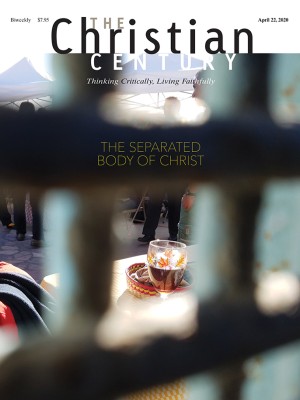Four guidelines for improvising pastoral leadership through a pandemic
How do ministers lead in unnavigated territory? How do we hold out hope in the face of despair?

A pandemic is unlike any situation we hold in living memory. The challenge for pastors is enormous and complex.
How will ministers lead through unnavigated territory, meet moral obligations for loving our neighbors and ourselves, guide and care for our people in an unprecedented time of uncertainty, and hold out hope in the face of despair?
Here are four ways to improvise and reimagine pastoral leadership in a time of pandemic.
1. Bring people together while keeping social distance.
At the top of the list of things we must re-imagine is our most tried and true way of being the church. In a pandemic, we cannot call the community together to meet physically in one space for worship, study, and prayer.
Objections to changing this practice are deafening: But we need community in a time of crisis! We are small. It won’t affect us. It won’t be church otherwise! Nevertheless, many congregations have courageously cancelled services or moved them online. Others have kepts meeting in person, however, and show no intention of changing their plans going forward. The Centers for Disease Control and Prevention has called for limiting gatherings to 50 or fewer people, and the White House recommends staying under 10.
Read our latest issue or browse back issues.
The coronavirus is highly contagious, easily transmittable, and much more lethal than the flu. Precautions like social distance, handwashing, sanitizing surfaces, and refraining from touching will help us “flatten the curve” and slow down the spread of the coronavirus.
Church folks commonly express care through hugging, handshakes, high fives, and shared meals—including holy communion. These lifelong, meaningful practices are nearly impossible to change overnight. Church leaders can offer the gift of removing these possibilities by improvising new ways of meeting.
What do improvised practices look like? Now, gathering for Bible study and worship may happen by phone or online. Practices of prayer and fellowship get new life using old technologies like cards, letters, and phone calls. We speak to one another in love through email, texts, and social media. Justice and social action take shape in dropped off meals and digital donations that balance an abundance of caution with an abundance of care.
2. Prepare for the impossible—and keep it simple.
On March first no church leader could have anticipated the magnitude or impossibility of this moment. As retired Health and Human Services chief Mike Leavitt says, “Everything we do before a pandemic will seem alarmist. Everything we do after will seem inadequate.” Welcome to that “adaptive leadership moment” you heard about in seminary.
How does one prepare for the impossible? No one taught us that. Because no one knows for sure. All the regular, everyday problems are still here, and they are compounded and amplified by a pandemic that threatens common ways of life. Every problem we face—from restocking the toilet paper to housing the homeless—looks overwhelming. There are no mentors who have been here before. We are simply all here now.
An amazing part of this crisis is that our peers are creating and launching astounding resources to support pastoral staff and congregations. One reverberating theme is to let go of expecting that all our face-to-face, real time community can move online seamlessly.
Simplify everything. Make connecting times brief. Choose familiar music. Let each person come and go as they can. Center on stability and sustainability. Be willing to step back and start over. These approaches will nurture community and make the impossible a little less daunting.
3. Invite generosity amid fears of scarcity.
Churches and families face big fears and uncertainty about possible financial losses in a flagging economy. The financial strain is costly not only to our churches but also to the people in our community who depend on their support. More losses seem inevitable.
As pastoral leaders, we need to be creative about gathering resources. Ask openly and honestly. Make giving easy. Try Tithe.ly, Kindred, or Venmo. The more we focus on scarcity or fear, the more anxiety will grow. The more we focus on shared commitment, supporting each other, and generosity, the more trust and hope will grow.
The Gospel of John tells us Jesus inspired a crowd of 5,000 to pull bread and fish from their cloaks and baskets and share food with everyone. People called it a miracle. Our pastoral task is to invite a sense of sacred abundance to see us through. What does your congregation have up its individual and collective sleeves?
4. Offer people clear direction and steady connection.
We are now knee-deep in a world of worst-case scenarios. There are no easy decisions in a pandemic. Second guessing is on all lips: What if we are overreacting? Shouldn’t each person decide? What if we can’t reach consensus? Every morning pastors I know are making 500 decisions before breakfast. Self-doubt and critique rear their heads.
People are struggling with every kind of decision in their lives right now. Amid the crisis and uncertainty, every jagged edge of every relationship is already showing. Pastoral relationships are not exempt. Futures feel unmoored or on hold: weddings, graduations, trips, new jobs, selling a home, starting a business. Even funerals are delayed.
The late rabbi and therapist Edwin Friedman studied family and congregational systems. He noted that leading change requires offering to people both clear direction and steady connection. There are no easy answers, and occasionally not acting is the best decision. Offering small bits of stability and clear communication in midst of chaos will serve your congregation in this season.
And how will we improvise hope? Start by believing in the resiliency of your congregation. Lean into the presence and love of God. Speak the words of hope that we can, as singer Carrie Newcomer says, “Do this hard thing.”






